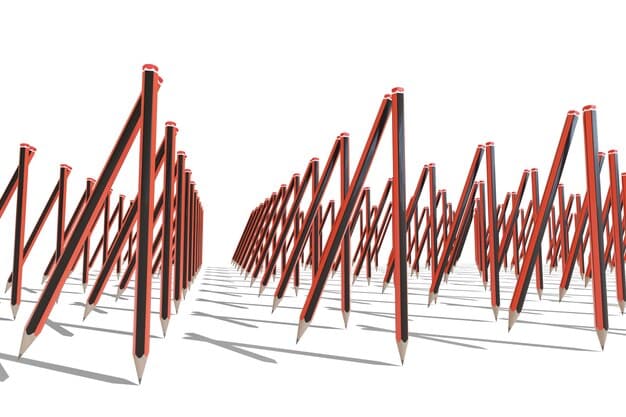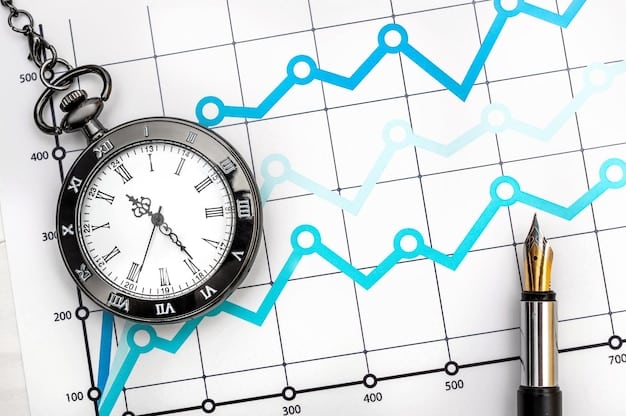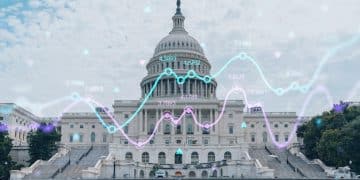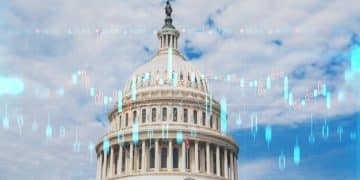Key Indicators of a US Recession in the Next 6 Months

Anúncios
To identify a potential recession in the US economy within the next 6 months, it’s crucial to monitor key indicators like GDP growth, employment rates, inflation trends, consumer spending, and the yield curve, as these provide insights into the overall economic health and potential downturns.
Are you concerned about the possibility of a recession in the US economy? Predicting economic downturns isn’t an exact science, but by monitoring key indicators, you can gain valuable insights. This article will cover what are the key indicators to watch for signs of a potential recession in the US Economy in the Next 6 Months?, helping you stay informed and prepared.
Anúncios
Understanding GDP Growth
Gross Domestic Product (GDP) is the broadest measure of economic activity. Significant declines in GDP over two consecutive quarters are a classic sign of a recession. Monitoring GDP growth provides a foundational understanding of the economy’s overall health.
What to Look For
Keep an eye on the quarterly GDP reports released by the Bureau of Economic Analysis (BEA). A negative GDP growth rate suggests that the economy is shrinking, which could signal an impending recession.
Anúncios
Analyzing the components of GDP, such as consumer spending, business investment, and government spending, can provide a more nuanced view. A decline in multiple components is a stronger indicator of trouble.
- Consistent Decline: Look for consecutive quarters of negative growth.
- Component Analysis: Evaluate which sectors are contributing to the decline.
- Historical Comparison: Compare current GDP trends to past recessionary periods.
Furthermore, revised GDP figures can offer a more accurate picture. Initial estimates are often adjusted as more data becomes available, so tracking these revisions is critical.
In conclusion, GDP growth is a primary indicator of economic health. Watching for consistent declines and analyzing the underlying components can offer valuable insights into the likelihood of a recession.
Employment Rates and Job Growth
The employment rate is a crucial indicator of economic stability. A healthy economy typically sees consistent job growth and low unemployment. Conversely, rising unemployment and declining job creation can herald a recession.
Initial Jobless Claims
Pay close attention to initial jobless claims, which are weekly reports on the number of people filing for unemployment benefits. A sudden spike can indicate mass layoffs and economic distress.
The monthly Employment Situation Report from the Bureau of Labor Statistics (BLS) offers a comprehensive overview of the labor market. Key metrics include the unemployment rate, non-farm payroll employment, and average hourly earnings.
- Unemployment Rate: A rising unemployment rate is a red flag.
- Non-Farm Payrolls: Decreases in non-farm payroll employment suggest businesses are cutting jobs.
- Labor Force Participation Rate: A decline in the participation rate may indicate people are giving up looking for work.
Additionally, monitor specific sectors. Job losses in key industries like manufacturing, construction, and finance can have a ripple effect throughout the economy.
In conclusion, monitoring employment rates and job growth is essential. A weakening labor market is a strong signal of a potential economic downturn, making this a key area to watch closely.
Inflation Trends and the Federal Reserve
Inflation trends significantly impact economic stability. While moderate inflation is generally considered healthy, rapid or uncontrolled inflation can erode purchasing power and lead to economic instability. The Federal Reserve plays a crucial role in managing inflation.
The Consumer Price Index (CPI)
Keep tabs on the Consumer Price Index (CPI), which measures the average change over time in the prices paid by urban consumers for a basket of consumer goods and services. A rapid increase in CPI can signal rising inflation.
The Federal Reserve uses monetary policy tools to control inflation, such as adjusting the federal funds rate and conducting open market operations. Monitoring the Fed’s actions and statements can offer insights into their concerns about inflation and their plans to address it.

- Interest Rate Hikes: The Fed may raise interest rates to combat inflation.
- Quantitative Tightening: Reducing the money supply can also help curb inflation.
- Forward Guidance: Statements about future policy intentions can influence market expectations.
Deflation, or a sustained decrease in the general price level, can also be problematic. It can lead to decreased consumer spending and business investment, as people delay purchases in anticipation of lower prices. This can create a deflationary spiral, further weakening the economy.
In summary, inflation trends and the Federal Reserve’s actions are critical indicators. Monitoring CPI and the Fed’s policy decisions can provide valuable insights into the potential for economic instability.
Consumer Spending and Confidence
Consumer spending drives a significant portion of the US economy. When consumers are confident and willing to spend, the economy tends to thrive. Conversely, declining consumer confidence and reduced spending can signal trouble.
Retail Sales Data
Monitor retail sales data, which provides insights into consumer spending patterns. Declining retail sales suggest that consumers are cutting back on purchases, which can indicate a weakening economy.
The Consumer Confidence Index, published by the Conference Board, measures consumers’ feelings about the overall economy and their personal financial situations. A decline in consumer confidence can lead to reduced spending.
- Spending Habits: Track changes in spending on durable goods, non-durable goods, and services.
- Savings Rate: An increasing savings rate may indicate consumers are becoming more cautious.
- Debt Levels: High levels of consumer debt can make households more vulnerable to economic shocks.
Additionally, seasonal spending patterns can offer clues. Poor performance during key shopping periods like the holiday season can be a warning sign.
In conclusion, consumer spending and confidence are vital indicators. Monitoring retail sales data and consumer confidence indices can provide valuable insights into the potential for an economic downturn.
The Yield Curve
The yield curve is a graph that plots the interest rates of bonds with different maturities. It’s a key indicator financial professionals use to predict the economic outlook. An inverted yield curve, where short-term interest rates are higher than long-term rates, is often seen as a predictor of a recession.
Understanding Yield Curve Inversions
An inverted yield curve suggests that investors expect future economic growth to slow down. This occurs because investors demand a higher yield for short-term bonds and prefer the relative safety of longer-term bonds at lower yields.
Typically, a normal yield curve slopes upward, as investors demand higher yields for taking on the risk of lending money over a longer period. However, when the yield curve inverts, it indicates a lack of confidence in future economic prospects.
- Monitor Spread: Keep track of the difference between the 10-year Treasury yield and the 2-year Treasury yield.
- Historical Data: Examine how yield curve inversions have preceded past recessions.
- Market Sentiment: Analyze what factors are driving the yield curve inversion.
While not every yield curve inversion is followed by a recession, the historical correlation is strong enough to warrant close attention.
In summary, the yield curve is a valuable indicator of market sentiment and future economic expectations. An inverted yield curve can be a warning sign of a potential recession.
Housing Market Indicators
The housing market is a significant sector that reflects overall economic health. Declines in housing market activity can signal broader economic troubles. Monitoring key indicators like housing prices, sales, and construction is important.
New Home Sales and Construction
Pay attention to new home sales and housing starts, which provide insights into the demand for new houses and the level of construction activity. Declines in these areas can indicate a weakening economy.
The S&P CoreLogic Case-Shiller Home Price Index measures changes in home prices across major metropolitan areas. Declining home prices can lead to reduced consumer wealth and decreased spending.
- Mortgage Rates: Rising mortgage rates can dampen housing demand.
- Inventory Levels: An increasing inventory of unsold homes can put downward pressure on prices.
- Foreclosure Rates: A spike in foreclosure rates can indicate financial distress among homeowners.
Besides that, regional variations in housing market performance can offer clues. A widespread decline is more concerning than isolated regional issues.
In conclusion, housing market indicators are important signals of economic health. Monitoring housing prices, sales, and construction can provide valuable insights into potential economic downturns.
| Key Indicator | Brief Description |
|---|---|
| 📉 GDP Growth | Decline in GDP over two consecutive quarters. |
| 💼 Employment Rates | Rising unemployment and decreased job creation. |
| 💸 Inflation Trends | Rapid increase in CPI and Federal Reserve policy changes. |
| 🏠 Housing Market | Declines in new home sales and housing construction. |
Frequently Asked Questions
▼
A recession is typically defined as a significant decline in economic activity spread across the economy, lasting more than a few months, normally visible in real GDP, real income, employment, industrial production, and wholesale-retail sales.
▼
The Federal Reserve combats inflation primarily by using monetary policy tools such as adjusting the federal funds rate and conducting open market operations to influence borrowing costs and the money supply.
▼
The yield curve is considered a predictor because an inverted yield curve, where short-term rates are higher than long-term rates, often reflects investor expectations of slower future economic growth.
▼
Consumer spending is a major driver of the US economy, and it accounts for a significant portion of GDP. Declines in consumer spending can reduce overall economic activity and growth.
▼
Economic indicators are valuable tools for assessing economic health, but they are not foolproof. They should be used in combination and alongside other factors to better understand the current economic situation.
Conclusion
Monitoring key economic indicators is vital for understanding the potential for a recession in the US economy within the next 6 months. By keeping a close eye on GDP growth, employment rates, inflation trends, consumer spending, the yield curve, and housing market indicators, you can stay informed and be better prepared for any economic challenges that may arise. Staying proactive and informed is key to navigating uncertain economic times.





